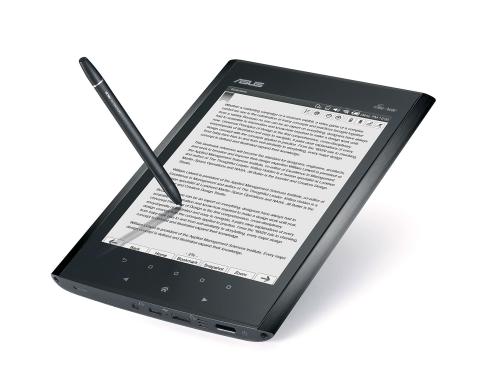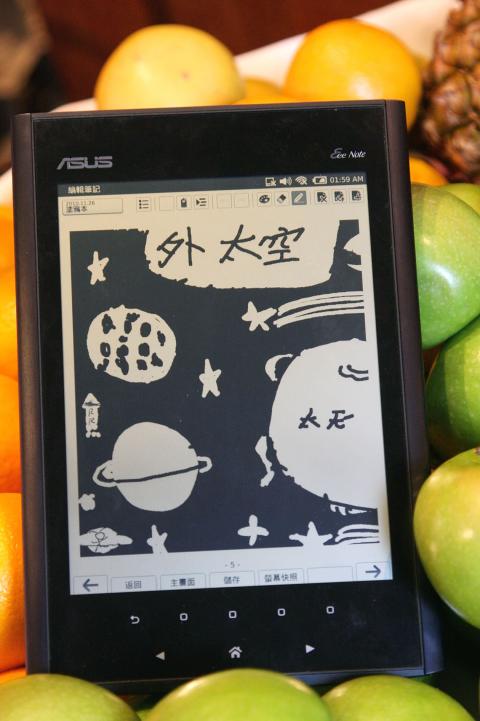Asus (華碩) is not an innovator along the lines of Apple or Google, but the company knows how to get a tech enthusiast’s attention. The Taiwanese computer manufacturer sparked a craze in 2007 with its Eee PC netbooks, which at the time were among the smallest and cheapest laptop computers around and even scored points for style.
One of Asus’ latest products in the Eee line of portable computers is the Eee Note EA800, a book-sized tablet device that the company calls a “digital notepad and eReader.”
But don’t let its appearance mislead you. The Eee Note is not a fancy touchscreen tablet computer, nor is it being touted as an answer to Apple’s iPad. And rightfully so. The Eee Note doesn’t have the buttery smooth, make-you-go-wow interface of an Apple iOS device.

Photo Courtesy of Asus
Instead, to navigate you have to use a special pen to tap to select an item, write or draw, much like one of the old Palm Pilots or similar PDAs. The Eee Note’s eight-inch screen displays everything in gray scale, not color. There are only a dozen or so rudimentary apps included and there is no app store to add more. The device runs on a modified version of the Linux operating system.
So why would anyone buy the Eee Note, which feels like a throwback to the last decade? It does a very respectable job as an electronic note-taker that simulates pen and paper, and it’s wired to sync those notes online with very little fuss. The Eee Note is also relatively inexpensive, retailing for NT$6,999.
If you’ve ever used a Wacom tablet, a digital pen and tablet set used by graphic designers and illustrators for creating drawings on PCs and Macs, then the Eee Note will feel familiar.

Photo Courtesy of Asus
On a Wacom tablet, which is basically a pressure sensitive mousepad, you use the pen to move the cursor, just like a mouse. The computer screen mimics the pen’s movements on the tablet.
The Eee Note takes the PC or Mac out of the equation. You can directly draw or write on the screen, or tap on the programs or files to open them. (And the Eee Note can even be used as a Wacom tablet when connected to a computer running Windows).
The centerpiece app of the Eee Note is “Notebook,” an electronic journal in which you can draw, write and paste in photos or voice recordings. You can create as many notebooks as you want and add pages within each notebook. There are more than 40 pre-set templates, which include blank pages for drawing, lined legal paper for notes, calendars and to-do lists with checkboxes.
In general, the app works pretty well for doodling and jotting down quick notes. It won’t replace pen and paper, at least for me, but the Eee Note is very accurate. Handwriting on the device looks just like your handwriting on paper.
If you like to draw, then you’ll probably appreciate Eee Note’s variety of pen strokes of varying thicknesses and styles: fountain pen, magic marker, pencil and highlight marker. And there are different shades of “ink.” Serious illustrators accustomed to pencil and paper might find the Eee Note frustrating at first, but it’s possible to create detailed, elaborate sketches.
A multimedia dimension to the notebooks can be added by importing photos or recordings made with the Eee Note’s built-in camera and voice recorder. The camera is two megapixels and takes mediocre color photos, which appear in black and white on the Eee Note (they can be viewed in color after copying the photos onto a computer). And you can even draw or write on photos pasted into a notebook. The voice recorder produces WAV files and the sound quality is good enough for taping something like a university lecture.
These features aren’t exactly groundbreaking, but what makes the Eee Note a modern device is its tight integration with Evernote, a very useful and free online service that uses “the cloud.” Evernote keeps all of your notes in cyberspace so they can be viewed and updated with multiple devices, whether a PC or smart phone. For example, say you made a note or sketch on the Eee Note, those files automatically appear on your computer when you open up the Evernote app (available for most computers and smart phones) and log in.
Using Evernote on the Eee Note is a set-it-and-forget-it deal. Go to settings, enter your account details and notebooks are automatically uploaded via the Eee Note’s Wi-Fi connection.
The Eee Note does a reasonable job as an e-Reader with its “Reader” app, which can display ePub and PDF formatted files. There are dedicated hardware buttons at the bottom of the device to flip to the next page in a book or magazine or navigate the table of contents.
But one major problem is that books can’t be downloaded from within the Reader app. Instead, when you click “download books,” the app switches to the Eee Note’s Web browser, which is just awful to use. It’s slow to open Web pages, especially the ebook retailer Kobo’s Web site (kobobooks.com), which the Eee Note automatically loads.
I found it impossible to navigate Kobo’s Web site on the Eee Note, so I gave up (I had better luck with www.gutenberg.org, which offers lots of free classic books, from The Adventures of Huckleberry Finn and Frankenstein to The Kama Sutra and Sun Tzu’s (孫子) The Art of War). For reading materials in Chinese, the Eee Reader directs users to the United Daily News’ ebooks Web site.
Microsoft Word documents can be viewed with the Reader app, but they have to be first converted to PDF files on a PC using the included Eee Sync software. You can also add files, whether books, documents or music, by using the device’s micro SD slot — the Eee Note allows SD cards with up to 16GB of storage space.
There’s a handful of additional apps, including a music player that plays either through the device’s loudspeaker or headphones, a calculator and a few simple games. These apps get the job done, but they still feel more like an afterthought. If you have an iPod Touch, iPhone or some similar touchscreen device, you’re better off using them. Navigating and tapping with the pen for anything other than drawing or jotting down notes feels awkward in comparison to a touchscreen.
In fact, one tough thing for me to overcome in using the Eee Note was the temptation to use my fingers. I’ve already been trained by the iPad to touch, tap and go.
Another quibble with the Eee Note is the screen. I can live without color, but the screen was too dark (it’s not nearly as bright as it appears in Asus’ promotional photo printed with this article). The brightness can’t be adjusted, which is annoying, and you have to be in a well-lit room to clearly see what you’re doing on the device.
The flip side to the Eee Note’s bare-bones features is price — the NT$7,000 price tag appears to have students in mind — and battery life. Asus claims over 13 hours; I managed over 8 hours using the device over the course of a week without recharging. Weighing 520g, which is about the same as a paperback travel book, the Eee Note isn’t much of a burden to carry.
It’s different strokes for different folks when it comes to the Eee Note. The device just doesn’t cut it when it comes to browsing the Web, but if you want something on which to read ebooks or PDFs, it will do in a pinch. And if you’re attracted to the Eee Note’s biggest strength — the ability to draw or write with a pen and its online syncing with Evernote — then it’s definitely worth considering. But if you’re looking for a cheap iPad alternative that does everything, this is not it.

The canonical shot of an East Asian city is a night skyline studded with towering apartment and office buildings, bright with neon and plastic signage, a landscape of energy and modernity. Another classic image is the same city seen from above, in which identical apartment towers march across the city, spilling out over nearby geography, like stylized soldiers colonizing new territory in a board game. Densely populated dynamic conurbations of money, technological innovation and convenience, it is hard to see the cities of East Asia as what they truly are: necropolises. Why is this? The East Asian development model, with

June 16 to June 22 The following flyer appeared on the streets of Hsinchu on June 12, 1895: “Taipei has already fallen to the Japanese barbarians, who have brought great misery to our land and people. We heard that the Japanese occupiers will tax our gardens, our houses, our bodies, and even our chickens, dogs, cows and pigs. They wear their hair wild, carve their teeth, tattoo their foreheads, wear strange clothes and speak a strange language. How can we be ruled by such people?” Posted by civilian militia leader Wu Tang-hsing (吳湯興), it was a call to arms to retake

This is a deeply unsettling period in Taiwan. Uncertainties are everywhere while everyone waits for a small army of other shoes to drop on nearly every front. During challenging times, interesting political changes can happen, yet all three major political parties are beset with scandals, strife and self-inflicted wounds. As the ruling party, the Democratic Progressive Party (DPP) is held accountable for not only the challenges to the party, but also the nation. Taiwan is geopolitically and economically under threat. Domestically, the administration is under siege by the opposition-controlled legislature and growing discontent with what opponents characterize as arrogant, autocratic

When Lisa, 20, laces into her ultra-high heels for her shift at a strip club in Ukraine’s Kharkiv, she knows that aside from dancing, she will have to comfort traumatized soldiers. Since Russia’s 2022 invasion, exhausted troops are the main clientele of the Flash Dancers club in the center of the northeastern city, just 20 kilometers from Russian forces. For some customers, it provides an “escape” from the war, said Valerya Zavatska — a 25-year-old law graduate who runs the club with her mother, an ex-dancer. But many are not there just for the show. They “want to talk about what hurts,” she